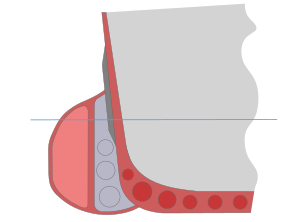
HMS Glatton in drydock, circa 1914–1918. Note the width of the torpedo bulge
The anti-torpedo bulge (also known as an anti-torpedo blister) is a form of passive defence against naval torpedoes that featured in warship construction in the period between the First and Second World Wars.
Theory and form[]
Essentially, the bulge is a lateral compartment at the waterline level that is isolated from the ship's internal volume. It is part air-filled, and part free-flooding. In theory, a torpedo strike will rupture and flood the outer air-filled component of the bulge and the inner water-filled part will dissipate the shock and absorb explosive fragments, leaving the ship's main hull structurally intact. Transverse bulkheads within the bulge limit flooding throughout the entirety of the structure.

A schematic cross-section of a ship with anti-torpedo bulges.[nb 1]
The bulge was developed by the British Director of Naval Construction, Eustace Tennyson-D'Eyncourt, who had four old Edgar-class protected cruisers so fitted in 1914. These ships were used for shore bombardment duties, and so were exposed to inshore submarine and torpedo boat attack. Grafton was torpedoed in 1917, and apart from a few minor splinter holes, the damage was confined to the bulge and the ship safely made port. Edgar was hit in 1918, this time damage to the elderly hull was confined to dented plating. The Royal Navy had all new construction fitted with bulges from 1914, beginning with the Revenge-class battleships. Older ships also had bulges incorporated during refits. The Royal Navy had its large monitors fitted with enormous bulges. This was fortuitous for Terror, which survived three torpedoes striking the hull forward, and for her sister Erebus, which survived a direct hit from a remotely-controlled explosive motor boat that ripped off 50 feet (15.25 m) of her bulge.
Later designs of bulges incorporated various combinations of air and water filled compartments and packing of wood and sealed tubes. As bulges increased a ship's beam, they caused a reduction in speed, which is a function of the length-to-beam ratio[citation needed]. Therefore, various combinations of narrow and internal bulges appeared throughout the 1920s and into the 1930s. The bulge had disappeared from construction in the 1930s, being replaced by internal arrangements of compartments with a similar function.
Anti-torpedo bulges were still added as retrofits to older ships, such as HMS Renown and USS Arizona.
Obsolescence[]
For greater effect, modern torpedoes are designed to explode beneath the hull of the target[citation needed] so they rarely strike the side of the ship directly.
See also[]
References[]
- Footnotes
- ↑ The inner bulge is free-flooding and filled with water. The other layer is filled with air. Lateral baffles prevent the entire bulge flooding in the event of it being pierced. Notice that the main belt (dark grey) only extends to just below the waterline.
- Bibliography
- Derek K. Brown (2003). The Grand Fleet; Warship Design and Development 1906–1922. Chatham Publishing. ISBN 1-84067-531-4.
The original article can be found at Anti-torpedo bulge and the edit history here.